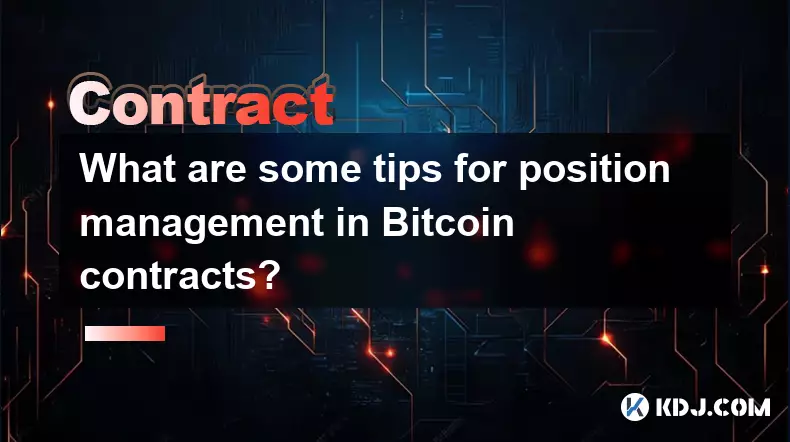-
 bitcoin
bitcoin $114320.977035 USD
-0.40% -
 ethereum
ethereum $4152.439985 USD
-1.75% -
 tether
tether $1.000111 USD
-0.04% -
 xrp
xrp $2.843037 USD
-1.63% -
 bnb
bnb $1013.349380 USD
-1.62% -
 solana
solana $208.362767 USD
-2.10% -
 usd-coin
usd-coin $0.999783 USD
0.00% -
 dogecoin
dogecoin $0.232559 USD
-1.00% -
 tron
tron $0.333491 USD
-1.09% -
 cardano
cardano $0.806310 USD
0.19% -
 hyperliquid
hyperliquid $45.023720 USD
-1.59% -
 ethena-usde
ethena-usde $1.000819 USD
-0.06% -
 chainlink
chainlink $21.241249 USD
-2.11% -
 avalanche
avalanche $30.035416 USD
-0.66% -
 stellar
stellar $0.364984 USD
-2.05%
What are some tips for position management in Bitcoin contracts?
Set clear entry/exit points, use 1–5% position sizing, monitor liquidation prices, avoid over-leveraging, and watch funding rates to manage Bitcoin contract risks effectively.
Sep 27, 2025 at 04:18 am

Tips for Effective Position Management in Bitcoin Contracts
1. Establish clear entry and exit points before opening any position. Traders should define their target profit levels and stop-loss thresholds based on technical analysis, market structure, and volatility indicators. This helps prevent emotional decision-making during fast-moving price swings.
2. Use position sizing to control risk exposure. Allocate only a small percentage of total capital—typically between 1% to 5%—per trade. This ensures that even a string of losing trades won’t significantly deplete the trading account.
3. Monitor liquidation prices closely, especially when using high leverage. Exchanges display the estimated liquidation price for open positions; staying aware of this level allows traders to adjust margin or reduce position size proactively.
4. Avoid over-leveraging, even when confidence is high. While leverage amplifies gains, it also increases the likelihood of liquidation during sharp reversals. A leverage ratio between 5x and 10x is often more sustainable than 25x or higher.
5. Keep an eye on funding rates in perpetual contracts. Negative funding means longs pay shorts, which may indicate overcrowded long positions. Positive funding can signal excessive shorting. Adjust positioning based on these incentives to avoid unfavorable costs.
Utilizing Stop-Loss and Take-Profit Strategically
1. Place stop-loss orders below key support levels for long positions or above resistance for shorts. These levels are determined through historical price action and volume analysis, offering statistically relevant areas where reversals are likely.
2. Consider using trailing stop-loss mechanisms to lock in profits as the market moves favorably. This tool automatically adjusts the stop-loss upward (for longs) or downward (for shorts), preserving gains without requiring constant manual oversight.
3. Set take-profit targets at measured move projections or Fibonacci extensions. For example, after a breakout, projecting a 1.618 extension of the prior impulse wave provides a logical exit zone.
4. Split take-profit execution into multiple tranches. Close part of the position at a conservative target and let the remainder ride with a trailing stop. This balances profit realization with potential for larger gains.
5. Never disable stop-loss orders under the assumption that the market will “come back.” Bitcoin’s volatility can trigger rapid cascading liquidations, and hope-based trading often leads to significant losses.
Monitoring Market Sentiment and On-Chain Data
1. Track on-chain metrics such as exchange inflows and outflows. A surge in BTC moving to exchanges may signal upcoming selling pressure, prompting tighter risk controls on open long positions.
2. Analyze open interest trends across major futures markets. Rising open interest alongside increasing price suggests new money entering the market, supporting trend continuation. Declining open interest during a rally may indicate short covering rather than genuine bullish momentum.
3. Watch for large liquidation clusters using heatmap tools. If a dense wall of long liquidations exists just above the current price, a short-term spike could trigger a stop-run, leading to abrupt volatility.
4. Follow whale wallet activity through blockchain explorers and analytics platforms. Large transfers to or from custodial wallets can precede institutional-sized trades that influence short-term direction.
5. Incorporate social sentiment gauges like the Fear & Greed Index to identify extremes. When greed peaks, consider reducing exposure or hedging open positions, as euphoria often precedes corrections.
Frequently Asked Questions
What is the ideal leverage for Bitcoin futures trading?There is no universal ideal leverage, but most professional traders recommend staying between 2x and 10x. Higher leverage increases liquidation risk significantly, especially during news-driven volatility. Conservative leverage allows more room for price fluctuation without triggering margin calls.
How do I calculate my liquidation price?Most exchanges provide a real-time liquidation price for each open contract. It’s calculated based on entry price, leverage, position size, and maintenance margin requirements. Manual calculation involves subtracting the maintenance margin from the collateral and determining the price point where equity falls to zero.
Should I hold Bitcoin futures positions over weekends?Holding positions over weekends carries added risk due to lower liquidity and potential for gap openings caused by global macro events or regulatory news. Many traders prefer to close or reduce positions before Friday close, particularly during uncertain market phases.
Can I hedge my spot Bitcoin holdings with futures?Yes, shorting Bitcoin futures while holding physical BTC acts as a hedge against market downturns. This strategy protects portfolio value during bearish periods without selling actual assets, allowing participation in future rallies once the hedge is removed.
Disclaimer:info@kdj.com
The information provided is not trading advice. kdj.com does not assume any responsibility for any investments made based on the information provided in this article. Cryptocurrencies are highly volatile and it is highly recommended that you invest with caution after thorough research!
If you believe that the content used on this website infringes your copyright, please contact us immediately (info@kdj.com) and we will delete it promptly.
- BlockDAG, DOGE, HYPE Sponsorship: Crypto Trends Shaping 2025
- 2025-10-01 00:25:13
- Deutsche Börse and Circle: A StableCoin Adoption Powerhouse in Europe
- 2025-10-01 00:25:13
- BlockDAG's Presale Buzz: Is It the Crypto to Watch in October 2025?
- 2025-10-01 00:30:13
- Bitcoin, Crypto, and IQ: When Genius Meets Digital Gold?
- 2025-10-01 00:30:13
- Stablecoins, American Innovation, and Wallet Tokens: The Next Frontier
- 2025-10-01 00:35:12
- NBU, Coins, and Crypto in Ukraine: A New Yorker's Take
- 2025-10-01 00:45:14
Related knowledge

How to calculate the required initial margin for Ethereum contracts?
Oct 01,2025 at 06:01am
Understanding Initial Margin in Ethereum Futures1. The initial margin for Ethereum futures contracts represents the minimum amount of capital a trader...

What is a perpetual swap for Bitcoin contracts?
Oct 01,2025 at 08:18am
Understanding Perpetual Swaps in Bitcoin Trading1. A perpetual swap is a type of derivative contract that allows traders to speculate on the price of ...

What is the best platform for trading SOL contracts?
Oct 01,2025 at 06:36am
Understanding the Role of Decentralized Exchanges in Modern Crypto Trading1. Decentralized exchanges (DEXs) have reshaped how traders interact with di...

How to short sell Bitcoin using futures contracts?
Oct 01,2025 at 02:54am
Understanding the Role of Decentralized Exchanges in Crypto Trading1. Decentralized exchanges (DEXs) have become a cornerstone of the cryptocurrency e...

Are PEPE contracts a good way to trade volatility?
Oct 01,2025 at 04:18am
Understanding PEPE Contracts in the Cryptocurrency Market1. PEPE contracts, derived from the broader meme coin movement, have gained attention due to ...

What is the funding rate for Ethereum contracts and how does it work?
Oct 01,2025 at 10:54am
Funding Rate Mechanism in Ethereum Derivatives1. The funding rate is a periodic payment exchanged between long and short positions in perpetual future...

How to calculate the required initial margin for Ethereum contracts?
Oct 01,2025 at 06:01am
Understanding Initial Margin in Ethereum Futures1. The initial margin for Ethereum futures contracts represents the minimum amount of capital a trader...

What is a perpetual swap for Bitcoin contracts?
Oct 01,2025 at 08:18am
Understanding Perpetual Swaps in Bitcoin Trading1. A perpetual swap is a type of derivative contract that allows traders to speculate on the price of ...

What is the best platform for trading SOL contracts?
Oct 01,2025 at 06:36am
Understanding the Role of Decentralized Exchanges in Modern Crypto Trading1. Decentralized exchanges (DEXs) have reshaped how traders interact with di...

How to short sell Bitcoin using futures contracts?
Oct 01,2025 at 02:54am
Understanding the Role of Decentralized Exchanges in Crypto Trading1. Decentralized exchanges (DEXs) have become a cornerstone of the cryptocurrency e...

Are PEPE contracts a good way to trade volatility?
Oct 01,2025 at 04:18am
Understanding PEPE Contracts in the Cryptocurrency Market1. PEPE contracts, derived from the broader meme coin movement, have gained attention due to ...

What is the funding rate for Ethereum contracts and how does it work?
Oct 01,2025 at 10:54am
Funding Rate Mechanism in Ethereum Derivatives1. The funding rate is a periodic payment exchanged between long and short positions in perpetual future...
See all articles










































































